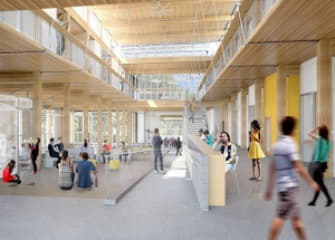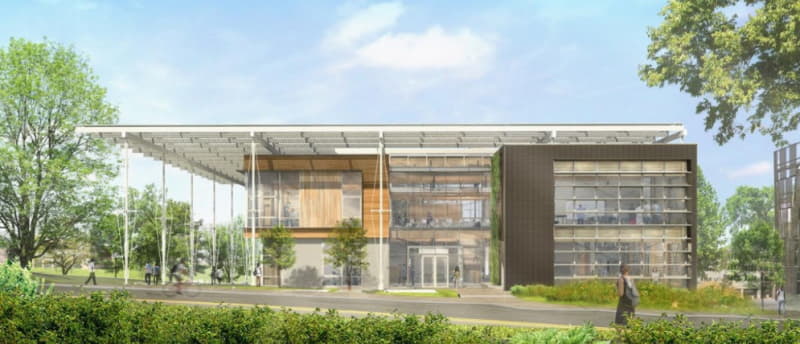
Project aims for Living Building Challenge 3.1 certification
Skanska USA, the Georgia Institute of Technology (Georgia Tech) and The Kendeda Fund recently celebrated the launch of The Kendeda Building for Innovative Sustainable Design.Instead of breaking ground on the building with a ceremonial shovel, representatives from Georgia Tech joined the design and construction teams to signal the launch of construction by planting seeds. When completed, the building is expected to be the most environmentally advanced education and research building in the Southeast.

The Kendeda Building is being built to meet the strict criteria of and receive a certification from the International Living Future Institute’s Living Building Challenge 3.1 Standard. Instead of simply minimizing energy and water use, a Living Building is designed to implement solutions for a net-positive impact on the environment – producing more energy and water than it consumes. In a climate as challenging as Atlanta’s, that is no small task. The Miller Hull Partnershipand Lord Aeck Sargent are leading the design.
“Georgia Tech is excited to work with Skanska on this transformative endeavor. With a wealth of experience in constructing sustainable buildings, Skanska has an abundance of knowledge about what works and how challenges can be transformed into opportunities,” said John DuConge, senior project manager for Design & Construction in Facilities Management at Georgia Tech.
Georgia’s heat and humidity provide unique environmental challenges. Atlanta and its environs have been classified as an urban heat island – a metropolitan area that is significantly warmer than surrounding rural areas. Dense building and ubiquitous concrete generate and retain heat, making city temperatures noticeably higher and even impacting regional rainfall and the length of local growing seasons. This is also contributing to decreased air quality and distressed ecosystems as warmer water flows into area watersheds. Variable fresh water supplies and increased consciousness of the fragility of those sources have spurred interest in strategies to conserve water, reduce runoff and recycle as much water as possible.
A Living Building actively combats those effects. Lighter building surfaces reflect more sunlight and absorb less heat. Green roofs and urban forests serve as insulators during warm weather months and the plants that comprise them absorb carbon dioxide and cool their surrounding environment. Recycling rainwater for flushing toilets, planting gardens and trees on rooftops, using natural light to illuminate workspaces, augmenting insulation to decrease energy spent on heating and cooling – these all contribute to a more efficient building that can simultaneously be beautiful and inviting.
“Innovations we use in The Kendeda Building for Innovative Sustainable Design have the potential to change construction standards in this whole region. With recent weather events, people have never been more interested in the resiliency and sustainability of construction projects,” said Scott Cannon, executive vice president and general manager of Skanska’s building operations in Georgia. “We’re trying to make things affordable, adaptable and replicable. When people see how seamlessly these solutions can be used, it opens the door for incorporating new ideas and engaging the natural world with the built environment.”
The Kendeda Fund and Georgia Tech are invested in developing and demonstrating a viable “urban” sustainable building and ecosystem model. The Living Building Challenge promotes regenerative planning and building techniques that align with Georgia Tech’s evolving landscape and its proposed master plans for Eco-Commons transformation, storm water management projects and campus arboretum. The campus itself is primed for collaboration. It hosts a variety of sophisticated research facilities dedicated to the discovery of net-zero energy solutions, like its Carbon Neutral Energy Solutions Laboratory. And it has launched a number of sustainability-related initiatives to generate community involvement and harness the strengths of local talent and interest.
“This project is more than a building; it represents a commitment to using this campus as a living, learning laboratory for hands-on educational and research opportunities that will be a model for the region and similar environments around the world,” said Dennis Creech, fund advisor for The Kendeda Fund. “Constructing this Living Building is a working endeavor to educate and transform the thinking of future engineers, planners, architects, and construction professionals. Its ripple effects will reach far beyond the campus alone.”
The Kendeda Building is designed to give back. Funded by a $30 million grant from the Kendeda Fund, an Atlanta-based foundation that invests in transformative leaders and ideas, the building’s construction and ongoing programming activities are intended to draw people together. It will house co-located academic and research departments as well as student-centric activities. Events and tours to showcase its unique features are envisioned to make the building widely accessible and increase its benefits to the surrounding community.
The Kendeda Fund is a committed supporter of ecological and social causes. This investment represents the foundation’s largest single grant to date and ranks among the largest capital gifts ever received by Georgia Tech. With the start of construction on The Kendeda Building later this winter, the building is on pace for occupancy in 2019, with building certification anticipated in 2020.
There are currently only 11 fully certified Living Buildings in the United States. The Living Building project at Georgia Tech brings Skanska’s current experience on LBC projects to seven, including two projects constructed and fully certified, and five others in various design phases. Fully certified and completed LBC projects are the Bertschi School Living Science Building in Seattle, Washington and the Brock Environmental Center in Virginia Beach, Virginia where Skanska was the program manager. Other current LBC projects include a home demonstration project at a college campus in Florida; an environmental learning center at a park in Alabama; a testing and teaching lab at a college campus in Washington State; and an office building in Seattle. Skanska is performing various roles on these projects, including general contractor, preconstruction manager, construction manager, design-build contractor, and consultant.
About Skanska
Skanska USA is one of the largest, most financially sound construction and development companies in the U.S., serving a broad range of clients including those in transportation, power, industrial, water/wastewater, healthcare, education, sports, data centers, government, aviation and commercial. Headquartered in New York with offices in 31 metro areas, we have more than 10,000 employees committed to being leaders in safety, project execution, sustainability, ethics and people development. In 2016, our work in building construction, civil and power/industrial construction, commercial development and infrastructure development (public-private partnerships) generated $6.8 billion in revenue. Global revenue of parent company Skanska AB, headquartered in Stockholm and listed on the Stockholm Stock Exchange, totaled $17.7 billion in 2016. Skanska shares are publicly traded in the U.S. on the OTC market under the symbol SKBSY through a Level I American Depository Receipt program.
About The Kendeda Fund
The Kendeda Fund is a private grantmaking foundation that invests in transformative leaders and ideas, empowering communities across the U.S. and around the globe to enhance equity, vibrancy, resourcefulness, and resilience. The Fund is one of the leading philanthropic investors in civic and environmental programs in the Atlanta area, and is committed to providing solutions to social and ecological challenges at the local and national levels. It accomplishes its mission by advancing green building design, community-design and public interest architecture; championing community wealth building and sustainability strategies; and leveraging innovation of cities to advance equity and sustainability. Learn more at www.kendedafund.org.
About the Georgia Institute of TechnologyThe Georgia Institute of Technology, also known as Georgia Tech, is one of the nation’s leading research universities — a university that embraces change while continually creating the next. The next generation of leaders. The next breakthrough startup company. The next life-saving medical treatment.
Georgia Tech provides a focused, technologically based education to more than 25,000 undergraduate and graduate students. Georgia Tech has many nationally recognized programs, all top-ranked by peers and publications alike, and is ranked in the nation’s top 10 public universities by U.S. News and World Report. It offers degrees through the Colleges of Computing, Design, Engineering, Sciences, the Scheller College of Business, and the Ivan Allen College of Liberal Arts. As a leading technological university, Georgia Tech has more than 100 centers focused on interdisciplinary research that consistently contribute vital research and innovation to American government, industry, and business.










